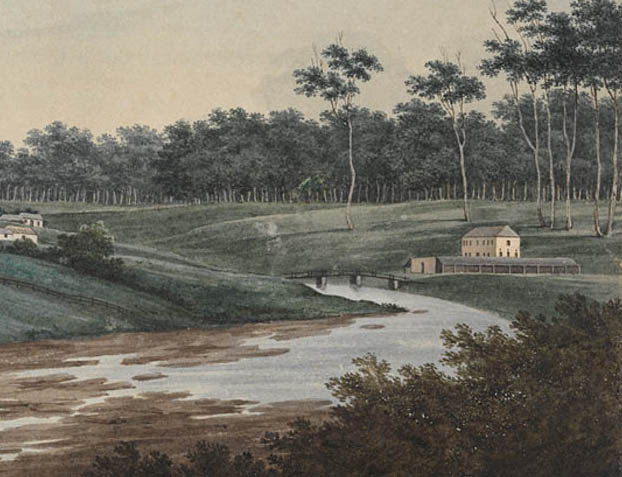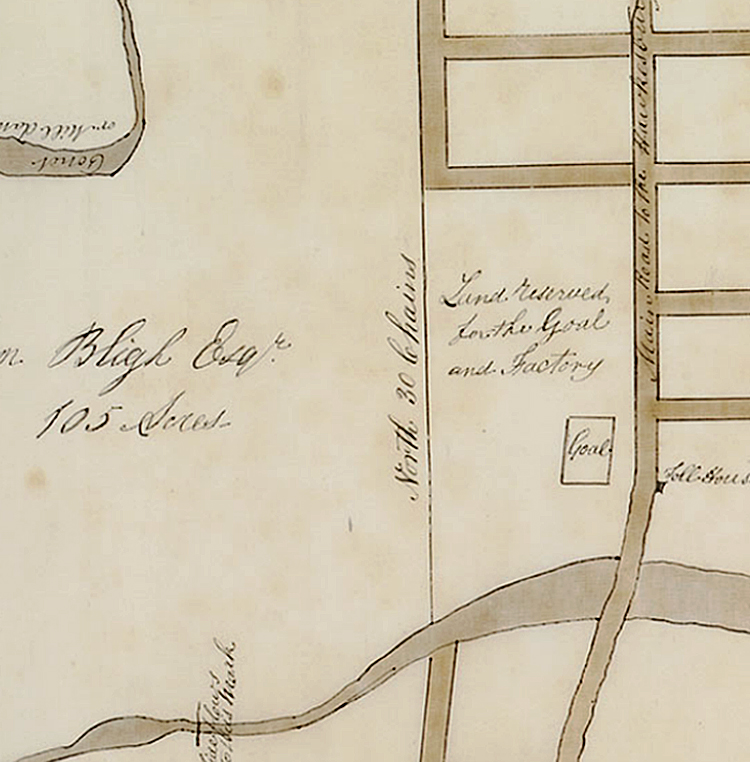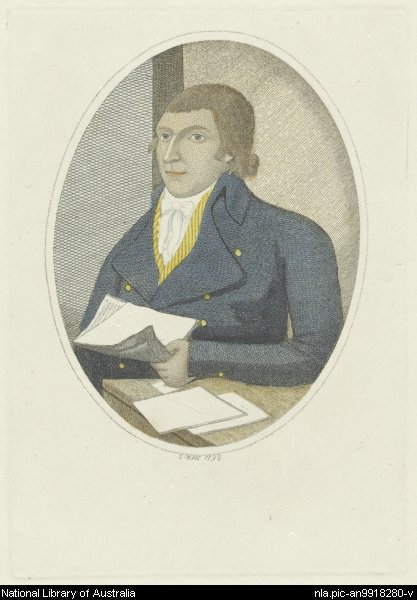The Dictionary of Sydney was archived in 2021.
Factory Above the Gaol
Citation
Persistent URL for this entry
To cite this entry in text
To cite this entry in a Wikipedia footnote citation
To cite this entry as a Wikipedia External link
Factory Above the Gaol
Australia's [media]first Female Factory was established near the southern boundary of what is now known as Prince Alfred Park, Parramatta, around 1802. From its humble inception, the factory was intended to be a place where unassigned female convicts would be gainfully employed in tasks that were beneficial to the colony; where their basic need for shelter was provided; and where 'corrupting influences' could be kept at bay.
Public morality
[media]The colonial elite were concerned with public morality and believed that corrupting influences could not be permitted to take hold in the young colony. In the early years, female convicts were deemed to be at particularly high risk owing to the fact that they were rarely assigned to a master immediately upon arrival in the colony. Since barracks for unassigned women did not previously exist in Parramatta, having no master meant having no accommodation. While convict women with money soon 'found friends' willing to lease them a bed or room and take them off government-supported rations, [1] those without family, friends and income became active participants in the colonial economy through what Paula J Byrnes has called their 'clever' use of 'sexuality, exchange and money.' [2]
Many women quickly involved themselves in this economy by selling off personal property at public houses like James Squire's Malting Shovel Inn, cohabiting with men, or prostituting themselves. [3] For some enterprising female convicts this enabled them to acquire a large number of properties that they subsequently rented out, thus providing themselves with a steady income. Such activities, however, were plainly of the sort considered immoral by the standards of the day. [4] Parramatta magistrate Reverend Samuel Marsden expressed this attitude when he asserted that these activities were 'destructive of all religion, morality and good order.' [5]
Women who had no property of their own to sell or exchange resumed the criminal activities common to their pre-transportation existence such as stealing what they needed, or in some cases wanted. David Kent and Norma Townsend caution that not all convict women were hapless, passive victims; their individual agency varied from one extreme to another. Where some female convicts were harshly punished for a single minor offence committed solely to acquire the bare necessities of life, [6] others were punished for crimes they were compelled to commit for other reasons, including greed. [7]
Humble beginnings
[media]The Female Factory was located on the site of the former convict womens' huts (1790s) and later, Parramatta's first two gaols. [8] A fire set by inmates destroyed the first wooden gaol in 1799 and construction began in August 1802 on a second, two-storey stone prison on the same site. It was during the construction of this second gaol – supervised by Marsden – that Governor King seized the opportunity to solve the problem of accommodating, and protecting the virtue of, the colony's abundance of unemployed convict women. Two 80 by 20 foot (approximately 24 by 6 metre) rooms on the second floor of Parramatta's second gaol became 'the factory above the gaol,' serving as a wool and linen factory where the women worked during the day, and a refuge for them where they slept at night. The female convicts also used the yard associated with the factory. [9] Called the 'Gaol Green' or 'Hanging Green', it was where court-ordered punishments (typically being put in 'the stocks' as well as executions) also took place.
In its industrial capacity, the factory excelled in its early years. Women wove a variety of fabrics including fine linen, sailcloth, duck and wool, and sacking under the guidance of political prisoner, master-weaver and superintendent of male and female convicts, George Mealmaker. [10] [media]By August 1804, nine looms were in operation, which soon grew to twelve. The yards of cloth produced were taken to the Commissariat Store – a two-storey building at the nearby Queen's Wharf – where the 'Parramatta cloth' was exchanged for wheat. [11] However, the success of the manufactory was undercut by the weathering and instability of the building itself which was in a constant state of disrepair due to the sandstone being laid 'off its bed,' deliberately or otherwise, by convict labourers. [12] In December 1807 the factory was forced to cease operations due to a fire that damaged both the factory and the gaol and did not reopen until May1809.
Neglect and overcrowding
[media]As a refuge-cum-guardian of public morality, the factory fell considerably short. With the female convict population ever increasing, the majority of women who worked there during the day faced severe overcrowding and could not find space to sleep. Many women had children with them and continued to find themselves fully exposed to the many vices of what Marsden called the 'sink of iniquity': Parramatta. [13] Marsden described in detail the extent of the overcrowding problem in a letter to Governor Macquarie in 1815;
The number of women employed at the factory under Mr. Oakes the superintendent is one hundred and fifty; they have seventy children; there is not any room in the factory that can be called a bed-room for these women and children. There are only two rooms, and these are both occupied as work-shops, over the gaol, and are about eighty feet long and twenty wide. In these rooms there are forty-six women daily employed; twenty spinning wool upon the common wheel and twenty-six carding. There are also in them the warping-machine &c. belonging to the factory. These rooms are crowded all the day, and at night such women sleep in them as are confined for recent offences, among the wheels, wool, and cards, and a few others who have no means whatever of procuring a better abode. The average number of women who sleep in the factory is about thirty in the whole; many of these women have little and some no bedding; they all sleep on the floor; there is not a cradle or bedstead belonging to the factory. I do not deem it either safe or prudent that even thirty women should sleep in the factory which has been crowded all day with working people, could this be avoided, as the air must be bad and contagious.
Were the magistrate to compel even half the number of women with their children to sleep in the factory which belong to it, they could not exist. Not less than one hundred and twenty women are at large in the night to sleep where they can. Many of them pay four shillings per week for their lodgings and fire; they have no means but theft and prostitution to obtain this sum, and these vices are become so common and habitual, that the women will tell the magistrate that they have no other means to supply their necessities. [14]
Desperate to protect what virtues remained in his female parishioners, and to provide fallen women with the opportunity for moral reform, Marsden frequently asserted the need for a large, purpose-built barracks for female convicts. Yet, the factory's population continued to rise to around 200, and Marsden's cries went unheeded, until 1817 when an 'anonymous' letter – claiming Governor Macquarie's neglect of the female convict issue implied his acceptance of rampant prostitution – made the design and construction of Marsden's hoped-for female barracks a top priority. [15]
Construction began on the second Parramatta Female Factory in 1818 and it was in operation from early 1821 to approximately 1847 but even in the new building, overcrowding, poor conditions and limited rations were a constant problem. As for the first factory, the building continued to deteriorate and the gaol on its lower level was also relocated in the 1830s to the larger, purpose-built complex that still stands at its current location on the corner of Dunlop and New streets. This building served as Parramatta's gaol until it was decommissioned in October 2011.
A major institution
The first and second female factories operated in Parramatta for a combined total of 45 years, outlasting the convict transportation system itself by almost a decade. Approximately one-fifth of the approximately 24,960 women transported to Australia passed through its doors. Eleven more female factories were established throughout the Australian colonies but the institution at Parramatta was the original, the largest, and the one on which the rest were based. It is a staggering history that began with a humble female convict's hut erected at the boundary of a space that later became a small, public park and namesake of a Victorian prince.
References
Byrnes Paula J. 'A Colonial Female Economy: Sydney, Australia.' Social History 24, no 3 (Oct 1999): 287–293.
Hendriksen, Gay. 'Women Transported: Myth and Reality.' Paper presented at the National Archives of Australia, Canberra, 14 June 2009.
Terry Kass, Carol Liston and John McClymont. Eds. Parramatta: A Past Revealed. Parramatta: Parramatta City Council, 1996.
David Kent and Norma Townsend. 'Deborah Oxley's 'Female Convicts': An Accurate View of Working-Class Women? [with Reply]. Labour History, no 65 (Nov 1993): 179–199.
Samuel Marsden, Letter to His Excellency, 15 July 1815, 'Minutes of Evidence taken before SELECT'; House of Commons, 'Report from the Select Committee on the State of Gaols &c. (12 July 1819) in House of Commons, Selection of Reports and Papers of the House of Commons 51: Prisons. House of Commons, 1836.
Oxley, Deborah. Convict Maids: The Forced Migration of Women to Australia. Melbourne; Cambridge: Cambridge University Press, 1996.
Notes
[1] Paula J Byrnes, 'A Colonial Female Economy: Sydney, Australia' Social History 24, no 3 (Oct 1999): 288
[2] Paula J Byrnes, 'A Colonial Female Economy: Sydney, Australia' Social History 24, no 3 (Oct 1999): 288
[3] Some scholars, including Deborah Oxley, would add to this that the women brought existing skills that were transferrable to the Australian colonial context but that they were undervalued and unemployed. See Deborah Oxley, Convict Maids: The Forced Migration of Women to Australia (Melbourne; Cambridge: Cambridge University Press, 1996). However, David Kent and Norma Townsend have noted that while convict women did bring useful skills, the rest of Oxley et al's argument is the product of 'unsustained assertions derived from an ideological disposition to see female convicts as victims.' See David Kent and Norma Townsend, 'Deborah Oxley's 'Female Convicts': An Accurate View of Working-Class Women? [with Reply], Labour History, no 65, (Nov 1993): 180
[4] Byrnes, 'A Colonial Female Economy: Sydney, Australia,' Social History 24, no 3 (Oct 1999): 289
[5] Samuel Marsden, 'Letter from Rev. Samuel Marsden to Governor Macquarie, 19 July 1815' cited in Gay Hendriksen, 'Women Transported: Myth and Reality' (paper presented at the National Archives of Australia, Canberra, 14 June 2009)
[6] Hendriksen notes that '65.3 percent of women had no prior convictions and 28 per cent had one prior conviction. Only 7.9 percent had multiple convictions. This suggests that the majority were not of a crime class.' See Gay Hendriksen, 'Women Transported: Myth and Reality' (paper presented at the National Archives of Australia, Canberra, 14 June 2009)
[7] David Kent and Norma Townsend, 'Deborah Oxley's 'Female Convicts': An Accurate View of Working-Class Women? [with Reply], Labour History 65 (Nov 1993):181; Gay Hendriksen, 'Women Transported: Myth and Reality' (paper presented at the National Archives of Australia, Canberra, 14 June 2009); Judith Dunn, Colonial Ladies: Lovely, Lively and Lamentably Loose: Crime Reports from the Sydney Morning Herald Relating to the Female Factory, Parramatta, 1831–1835, (Winston Hills: Judith Dunn, 2008)
[8] 'Parramatta Female Factory Precinct,' Parramatta Female Factory Precinct Association, accessed 9 July 2014, http://www.parragirls.org.au/history.php
[9] NSW Heritage Register, 'Parramatta Archaeological Management Unit 3110 / Prince Alfred Park, First and Second Parramatta Gaols,' accessed 9 July 2014, http://www.environment.nsw.gov.au/heritageapp/ViewHeritageItemDetails.aspx?ID=2243110
[10] Terry Kass, Carol Liston and John McClymont, Parramatta: A Past Revealed (Parramatta: Parramatta City Council, 1996), 60–61
[11] Terry Kass, Carol Liston and John McClymont, Parramatta: A Past Revealed (Parramatta: Parramatta City Council, 1996), 60–61
[12] Terry Kass, Carol Liston and John McClymont, Parramatta: A Past Revealed (Parramatta: Parramatta City Council, 1996), 59; James Semple Kerr, Design for Convicts: An Account of Design for Convict Establishments in the Australian Colonies During the Transportation Era, (Sydney: Library of Australian History / National Trust of Australia (NSW), and the Australian Society for Historical Archaeology, 1984): 23; NSW Heritage Register, 'Parramatta Archaeological Management Unit 3110 / Prince Alfred Park, First and Second Parramatta Gaols,' accessed 9 July 2014, http://www.environment.nsw.gov.au/heritageapp/ViewHeritageItemDetails.aspx?ID=2243110
[13] Terry Kass, Carol Liston and John McClymont, Parramatta: A Past Revealed (Parramatta: Parramatta City Council, 1996), 85
[14] Samuel Marsden, Letter to his Excellency, 15 July 1815, 'Minutes of Evidence taken before SELECT'; House of Commons, 'Report from the Select Committee on the State of Gaols &c. (12 July 1819) in House of Commons, Selection of Reports and Papers of the House of Commons 51: Prisons (House of Commons, 1836), 82
[15] Samuel Marsden, Letter to his Excellency, 15 July 1815, 'Minutes of Evidence taken before SELECT'; House of Commons, 'Report from the Select Committee on the State of Gaols &c. (12 July 1819) in House of Commons, Selection of Reports and Papers of the House of Commons 51: Prisons (House of Commons, 1836), 82







